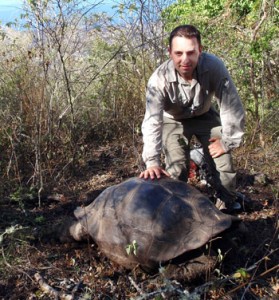“Extinct” Galápagos Tortoise Discovered in Captivity
Posted by: Loren Coleman on January 17th, 2010

UBC Okanagan conservation geneticist Michael Russello with a Galápagos giant tortoise. (Photo contributed)
Nine captive Galápagos tortoises have turned out to be an extinct species. New genetic research has identified the captive giant tortoises as descendants of an “extinct” species formerly endemic to Floreana Island in the Pacific’s Galápagos Islands. In an article published this week in the peer-reviewed online Public Library of Science journal PLoS ONE, the abstract notes:
Although not unusual to find captive relicts of species lost in the wild, rarely are presumed extinct species rediscovered outside of their native range. A recent study detected living descendents of an extinct Galápagos tortoise species (Chelonoidis elephantopus) once endemic to Floreana Island on the neighboring island of Isabela. This finding adds to the growing cryptic diversity detected among these species in the wild. There also exists a large number of Galápagos tortoises in captivity of ambiguous origin. The recently accumulated population-level haplotypic and genotypic data now available for C. elephantopus add a critical reference population to the existing database of 11 extant species for investigating the origin of captive individuals of unknown ancestry.
The finding caused one of the scientists, Michael Russello, a conservation geneticist at the University of British Columbia-Okanagan to tell the Kelowna newspaper,
We found nine tortoises that shared a high percentage of their sampled genome with the Floreana ‘extinct’ species – up to 94 per cent – and one tortoise may even be a pure-bred. The detection of these giant tortoises in captivity is particularly significant, as it enables a captive breeding program to get underway almost immediately.
It was also quite exciting that theses tortoises (six females and three males) are already living in captivity on Santa Cruz Island at the Galápagos National Park breeding centre, greatly facilitating conservation action.
“This is a story where humans can potentially right some previous wrongs,” Russello says.
Thanks to Kevin Stewart for the news tip.
About Loren Coleman
Loren Coleman is one of the world’s leading cryptozoologists, some say “the” leading living cryptozoologist. Certainly, he is acknowledged as the current living American researcher and writer who has most popularized cryptozoology in the late 20th and early 21st centuries.
Starting his fieldwork and investigations in 1960, after traveling and trekking extensively in pursuit of cryptozoological mysteries, Coleman began writing to share his experiences in 1969. An honorary member of Ivan T. Sanderson’s Society for the Investigation of the Unexplained in the 1970s, Coleman has been bestowed with similar honorary memberships of the North Idaho College Cryptozoology Club in 1983, and in subsequent years, that of the British Columbia Scientific Cryptozoology Club, CryptoSafari International, and other international organizations. He was also a Life Member and Benefactor of the International Society of Cryptozoology (now-defunct).
Loren Coleman’s daily blog, as a member of the Cryptomundo Team, served as an ongoing avenue of communication for the ever-growing body of cryptozoo news from 2005 through 2013. He returned as an infrequent contributor beginning Halloween week of 2015.
Coleman is the founder in 2003, and current director of the International Cryptozoology Museum in Portland, Maine.










Just 1 word-
! WONDERFUL !